Genomic and Immunological Characterization of Pyroptosis in Lung Adenocarcinoma
- PMID: 35938142
- PMCID: PMC9348947
- DOI: 10.1155/2022/6905588
Genomic and Immunological Characterization of Pyroptosis in Lung Adenocarcinoma
Abstract
Pyroptosis is a programmed cell death that may either promote or hinder cancer growth under different circumstances. Pyroptosis-related genes (PRGs) could be a useful target for cancer therapy, and are uncommon in lung adenocarcinoma (LUAD). The expression profiles, mutation data and clinical information of LUAD patients were included in this study. A pyroptosis-related prognostic risk score (PPRS) model was constructed by performing Cox regression, weighted gene co-expression network analysis (WGCNA), and least absolute shrinkage and selection operator (LASSO) analysis to score LUAD patients. Somatic mutation and copy number variation (CNV), tumor immunity, and sensitivity to immunotherapy/chemotherapy were compared between different PPRS groups. Clinical parameters of LUAD were combined with PPRS to construct a decision tree and nomogram. Red module was highly positively correlated with pyroptosis. Seven genes (FCRLB, COTL1, GNG10, CASP4, DOK1, CCR2, and AQP8) were screened from the red module to construct a PPRS model. Significantly lower overall survival (OS), higher incidence of somatic mutation and CNV, elevated infiltration level of the immune cell together with increased probability of immune escape were observed in LUAD patients with higher PPRS, and were more sensitive to Cisplatin, Docetaxel, and Vinorelbine. We constructed a new PPRS model for patients with LUAD. The model might have clinical significance in the prediction of the prognosis of patients with LUAD and in the efficacy of chemotherapy and immunotherapy.
Copyright © 2022 Yaobo Song et al.
Conflict of interest statement
The authors declare no potential conflicts of interest.
Figures
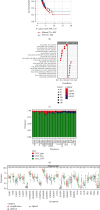
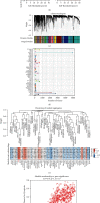


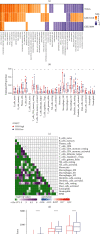
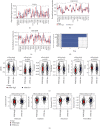
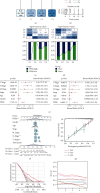
Similar articles
-
Novel molecular insights into pyroptosis in triple-negative breast cancer prognosis and immunotherapy.J Gene Med. 2024 Jan;26(1):e3645. doi: 10.1002/jgm.3645. Epub 2023 Dec 2. J Gene Med. 2024. PMID: 38041540
-
Identification of Pyroptosis-Relevant Signature in Tumor Immune Microenvironment and Prognosis in Skin Cutaneous Melanoma Using Network Analysis.Stem Cells Int. 2023 Feb 8;2023:3827999. doi: 10.1155/2023/3827999. eCollection 2023. Stem Cells Int. 2023. PMID: 36818162 Free PMC article.
-
A Pyroptosis-Related Signature Predicts Overall Survival and Immunotherapy Responses in Lung Adenocarcinoma.Front Genet. 2022 Jun 20;13:891301. doi: 10.3389/fgene.2022.891301. eCollection 2022. Front Genet. 2022. PMID: 35795208 Free PMC article.
-
A novel pyroptosis related genes signature for predicting prognosis and estimating tumor immune microenvironment in lung adenocarcinoma.Transl Cancer Res. 2022 Aug;11(8):2647-2659. doi: 10.21037/tcr-22-327. Transl Cancer Res. 2022. PMID: 36093538 Free PMC article.
-
Pyroptosis-based risk score predicts prognosis and drug sensitivity in lung adenocarcinoma.Open Med (Wars). 2023 Mar 13;18(1):20230663. doi: 10.1515/med-2023-0663. eCollection 2023. Open Med (Wars). 2023. PMID: 36941988 Free PMC article.
Cited by
-
DOKing tumor progression in ccRCC.J Cancer. 2024 Oct 15;15(19):6416-6417. doi: 10.7150/jca.104784. eCollection 2024. J Cancer. 2024. PMID: 39513127 Free PMC article. No abstract available.
-
Plasma cell signatures predict prognosis and treatment efficacy for lung adenocarcinoma.Cell Oncol (Dordr). 2024 Apr;47(2):555-571. doi: 10.1007/s13402-023-00883-w. Epub 2023 Oct 9. Cell Oncol (Dordr). 2024. PMID: 37814076
-
CRTAC1 identified as a promising diagnosis and prognostic biomarker in lung adenocarcinoma.Sci Rep. 2024 May 16;14(1):11223. doi: 10.1038/s41598-024-61804-x. Sci Rep. 2024. PMID: 38755183 Free PMC article.
References
LinkOut - more resources
Full Text Sources
Miscellaneous

